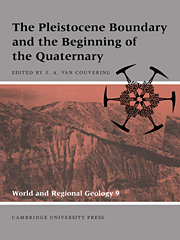Book contents
- Frontmatter
- Contents
- List of contributors
- Preface: the new Pleistocene
- Foreword
- Part I Definition of the base of the Quaternary
- Part II Characterization of the Pleistocene boundary-stratotype
- Part III The paleontological context of the Pleistocene boundary
- 7 The Pliocene–Pleistocene boundary in deep-sea sediments
- 8 Late Cenozoic changes of flora in extra-tropical Eurasia in the light of paleomagnetic stratigraphy
- 9 Plio–Pleistocene mammal faunas: an overview
- 10 Human evolution in the Plio–Pleistocene interval
- Part IV The Pleistocene boundary in regional sequences
- Index
7 - The Pliocene–Pleistocene boundary in deep-sea sediments
Published online by Cambridge University Press: 10 November 2009
- Frontmatter
- Contents
- List of contributors
- Preface: the new Pleistocene
- Foreword
- Part I Definition of the base of the Quaternary
- Part II Characterization of the Pleistocene boundary-stratotype
- Part III The paleontological context of the Pleistocene boundary
- 7 The Pliocene–Pleistocene boundary in deep-sea sediments
- 8 Late Cenozoic changes of flora in extra-tropical Eurasia in the light of paleomagnetic stratigraphy
- 9 Plio–Pleistocene mammal faunas: an overview
- 10 Human evolution in the Plio–Pleistocene interval
- Part IV The Pleistocene boundary in regional sequences
- Index
Summary
Introduction
This chapter is a summary of the major micropaleontological events that are represented in the stratigraphic record of deep-sea sediments over the past 2.5 m.y. The main focus is on those events associated with the Olduvai subchron, inasmuch as this is the time interval in which the Pliocene–Pleistocene boundary has now been located by formal action of the IUGS. Our discussion concentrates on three areas of particular interest: biostratigraphy, the history of oxygen-isotope variations, and carbonate stratigraphy.
Biostratigraphy
Boundary-stratotype section
Current studies on the proposed Vrica boundary-stratotype (Pasini and Colalongo, Chapter 2, this volume; Nakagawa et al., Chapter 3, this volume; Rio, Raffi, and Backman, Chapter 5, this volume; Palmer, Chapter 6, this volume) indicate that this definition places the Pliocene–Pleistocene boundary just above (or just within) the top of the Olduvai subchron of the Matuyama chron, with an estimated age of 1.81 Ma (Zijderveld et al., 1991; Pasini and Colalongo, Chapter 2, this volume), and that this level is bracketed below by the extinction, or LAD (last-appearance datum), of Discoaster brouweri and its triradiate variety, and above by the FAD (first-appearance datum) of Gephyrocapsa oceanica s.l. and the LAD of Calcidiscus macintyrei. The same relationships are seen in deep-sea cores (Figure 7.1). In foraminifera biostratigraphy, the boundary-stratotype is almost exactly coincident with the FAD of Globigerina cariacoensis. Other correlated events are the shift from dextral to sinistral coiling in most Neogloboquadrina pachyderma, the FAD of Globorotalia umbilicata, and (at a slightly earlier age) the last occurrence of Neogloboquadrina atlantica and first occurrence of Globigerina digitata digitata.
- Type
- Chapter
- Information
- The Pleistocene Boundary and the Beginning of the Quaternary , pp. 87 - 103Publisher: Cambridge University PressPrint publication year: 1996



